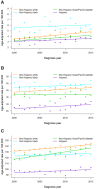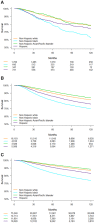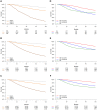Incidence and Survival Among Young Women With Stage I-III Breast Cancer: SEER 2000-2015
- PMID: 31392297
- PMCID: PMC6668585
- DOI: 10.1093/jncics/pkz040
Incidence and Survival Among Young Women With Stage I-III Breast Cancer: SEER 2000-2015
Abstract
Background: Although recent findings suggest that de novo stage IV breast cancer is increasing in premenopausal women in the United States, contemporary incidence and survival data are lacking for stage I-III cancer.
Methods: Women aged 20-29 (n = 3826), 30-39 (n = 34 585), and 40-49 (n = 126 552) years who were diagnosed with stage I-III breast cancer from 2000 to 2015 were identified from the Surveillance, Epidemiology, and End Results 18 registries database. Age-adjusted, average annual percentage changes in incidence and 5- and 10-year Kaplan-Meier survival curves were estimated by race and ethnicity, stage, and hormone receptor (HR) status and grade (low to well and moderately differentiated; high to poorly and undifferentiated) for each age decade.
Results: The average annual percentage change in incidence was positive for each age decade and was highest among women aged 20-29 years. Increased incidence was driven largely by HR+ cancer, particularly HR+ low-grade cancer in women aged 20-29 and 40-49 years. By 2015, incidence of HR+ low- and high-grade cancer each independently exceeded incidence of HR- cancer in each age decade. Survival for HR+ low- and high-grade cancer decreased with decreasing age; survival for HR- cancer was similar across age decades. Among all women aged 20-29 years, 10-year survival for HR+ high-grade cancer was lower than that for HR+ low-grade or HR- cancer. Among women aged 20-29 years with stage I cancer, 10-year survival was lowest for HR+ high-grade cancer.
Conclusions: HR+ breast cancer is increasing in incidence among premenopausal women, and HR+ high-grade cancer was associated with reduced survival among women aged 20-29 years. Our findings can help guide further evaluation of preventive, diagnostic, and therapeutic strategies for breast cancer among premenopausal women.
Figures




References
-
- Partridge AH, Hughes ME, Warner ET, et al. Subtype-dependent relationship between young age at diagnosis and breast cancer survival. J Clin Oncol. 2016;34(27):3308–3314. - PubMed
-
- Azim HA Jr, Michiels S, Bedard PL, et al. Elucidating prognosis and biology of breast cancer arising in young women using gene expression profiling. Clin Cancer Res. 2012;18(5):1341–1351. - PubMed
Grants and funding
LinkOut - more resources
Full Text Sources
